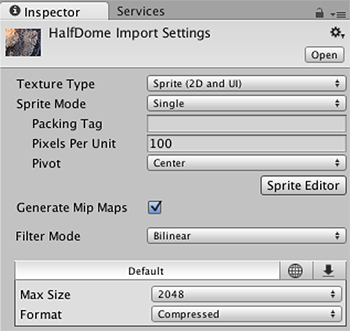- Unity User Manual (5.5)
- Unity 2D
- Sprites
Sprites
Sprites are 2D Graphic objects. If you are used to working in 3D, Sprites are essentially just standard textures but there are special techniques for combining and managing sprite textures for efficiency and convenience during development.
Unity provides a placeholder Sprite Creator, a built-in Sprite Editor, a Sprite Renderer and a Sprite Packer
See Importing and Setting up Sprites below for information on setting up assets as Sprites in your Unity project.
Sprite Tools
Sprite Creator
Use the Sprite Creator to create placeholder sprites in your project, so you can carry on with development without having to source or wait for graphics.
Sprite Editor
The Sprite Editor lets you extract sprite graphics from a larger image and edit a number of component images within a single texture in your image editor. You could use this, for example, to keep the arms, legs and body of a character as separate elements within one image.
Sprite Renderer
Sprites are rendered with a Sprite Renderer component rather than the Mesh Renderer used with 3D objects. Use it to display images as Sprites for use in both 2D and 3D scenes.
Sprite Packer
Use Sprite Packer to opimize the use and performance of video memory by your project.
Importing and Setting Up Sprites
Sprites are a type of Asset in Unity projects. You can see them, ready to use, via the Project View.
There are two ways to bring Sprites into your project:
-
In your computer’s Finder (Mac OS X) or File Explorer (Windows), place your image directly into your Unity project’s Assets folder.
Unity detects this and displays it in your project’s Project View.
-
In Unity, go to Assets>Import New Asset… to bring up your computer’s Finder (Mac OS X) or File Explorer (Windows).
From there, select the image you want, and Unity puts it in the Project View.
See Importing Assets for more details on this and important information about organising your Assets folder.
Setting your Image as a Sprite
If your project mode is set to 2D, the image you import is automatically set as a Sprite.
However, if your project mode is set to 3D, your image is set as a Texture, so you need to change the asset’s Texture Type:
Click on the asset to see its Import Inspector.
-
Set the Texture Type to Sprite (2D and UI).
(See Fig 1: Set Texture Type….)
See 2D or 3D Projects for details on setting your project mode to 2D.
